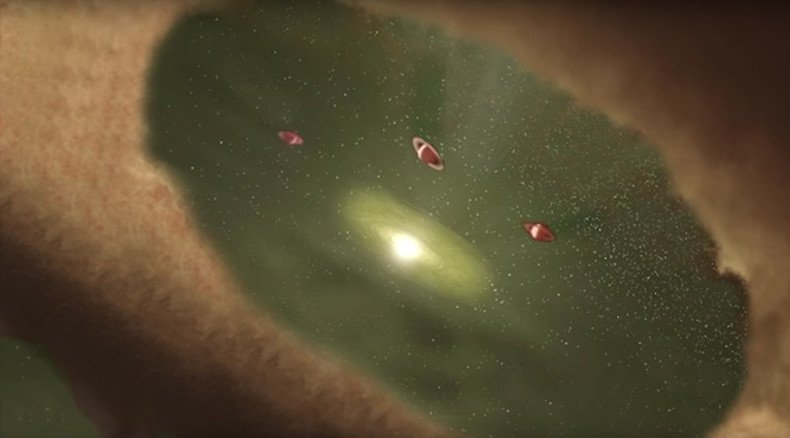It’s a baby-planet! Scientists watch new planet being born from dust (VIDEO)

Scientists have witnessed an unprecedented space miracle: They saw a new planet being born right before their eyes. The phenomenon, which even scientists had never seen before, has been recorded and shared online.
A juvenile planet formed around a young star named LkCa 15 in the neighborhood of Taurus, some 450 light years from Earth.
“This is the first time that we’ve imaged a planet that we can say is still forming,” said Stephanie Sallum, a University of Arizona graduate student who worked on the research.
Scientists, who were actually working separately at first, suspected that this particular galaxy might have an embryonic planet while doing previous research. Both Sallum and her colleague, Kate Follette, focused on LkCa15. However, the sensation here is not so much the new planet itself, but the process of its formation.
There are about 2,000 known exoplanets, but only about 10 have been imaged, and all long after they had formed. Scientists had never seen them during the process of their actual birth.
“No one has successfully and unambiguously detected a forming planet before,” Follette, a UA graduate currently working with Stanford University, said in a statement. “There have always been alternate explanations, but in this case we’ve taken a direct picture, and it’s hard to dispute that.”
Astronomers find ‘surprise’ pulsar, ‘most important planet ever’ outside solar system https://t.co/CwrK7gVY9Hpic.twitter.com/75noIN8sOg
— RT (@RT_com) November 13, 2015The answer lies in a doughnut-shaped disk of dust and gas that is created when a new star is born. It is theorized that planets form inside that disk, with dust and debris latching onto the globes as the material falls rather than remaining in the disk or falling onto the star. The new planet then resides in the gap that was left.
“The reason we selected this system is because it’s built around a very young star that has material left over from the star-formation process,” Follette said. “It’s like a big doughnut. This system is special because it’s one of a handful of disks that has a solar-system size gap in it. And one of the ways to create that gap is to have planets forming in there.”
The process is hard to catch, but Follette and Sallum used the world’s largest telescopes – the Large Binocular Telescope (LBT) located on Mount Graham in Arizona, the U of A’s Magellan Telescope and its adaptive optics system, and MagAO located in Chile.
The latter also captured the planet’s “hydrogen alpha,” a wavelength of light that almost all young stars are identified by. LkCa 15 and its planets also emit a dark red light as they grow, which corroborates the discovery.
Jupiter ejected its icy brother giant from solar system, its moon implies https://t.co/POKY0w17PFpic.twitter.com/VJMKVTL3pO
— RT (@RT_com) November 2, 2015“That single dark shade of red light is emitted by both the planet and the star as they undergo the same growing process,” Follette says. “We were able to separate the light of the faint planet from the light of the much brighter star and to see that they were both growing and glowing in this very distinct shade of red.”
The researchers’ results will be published in the November 19 issue of Nature.












